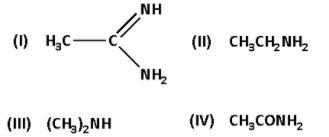
The correct basicity order of the following compound is:

A) I > III > II > IV
B) III > I > II > IV
C) II > I > III > IV
D) I > II > III > IV

Answer
476.1k+ views
Hint:More the number of the lone pair of electrons are available higher is the basicity. The basicity is directly proportional to the number of electron donating groups and is inversely proportional to the number of electron withdrawing groups.
Complete step-by-step answer:
In compound (I), there is a lone pair of electron on both the groups

Thus, in compound (I), there is one lone pair available, two electron donating groups and also conjugation is available.
In compound (II), there is a lone pair on the

Thus, in compound (II), there is one lone pair available, two electron donating groups from one side of the functional group but there is no conjugation.Thus, compound (I) is more basic than compound (II).
In compound (III), there is a lone pair on the
Thus, in compound (III), there is one lone pair available, two electron donating groups from both sides of the functional group.

Thus, compound (III) is more basic than compound (II).
In compound (IV), there is a lone pair of electrons on the
Thus, in compound (IV), there is no lone pair available and also, there is an electron withdrawing group which decreases the basicity.

Thus, compound (IV) is least basic. Thus, the correct basicity order is as follows:
I > III > II > IV
Thus, the correct answer is (A) I > III > II > IV.
Note: We should remember that
i) As the number of the electron donating groups increases the basicity of the compound increases.
ii) As the number of electron withdrawing groups increases the basicity of the compound decreases.
Complete step-by-step answer:
In compound (I), there is a lone pair of electron on both the groups

Thus, in compound (I), there is one lone pair available, two electron donating groups and also conjugation is available.
In compound (II), there is a lone pair on the

Thus, in compound (II), there is one lone pair available, two electron donating groups from one side of the functional group but there is no conjugation.Thus, compound (I) is more basic than compound (II).
In compound (III), there is a lone pair on the
Thus, in compound (III), there is one lone pair available, two electron donating groups from both sides of the functional group.

Thus, compound (III) is more basic than compound (II).
In compound (IV), there is a lone pair of electrons on the
Thus, in compound (IV), there is no lone pair available and also, there is an electron withdrawing group which decreases the basicity.

Thus, compound (IV) is least basic. Thus, the correct basicity order is as follows:
I > III > II > IV
Thus, the correct answer is (A) I > III > II > IV.
Note: We should remember that
i) As the number of the electron donating groups increases the basicity of the compound increases.
ii) As the number of electron withdrawing groups increases the basicity of the compound decreases.
Recently Updated Pages
Master Class 11 Economics: Engaging Questions & Answers for Success

Master Class 11 Business Studies: Engaging Questions & Answers for Success

Master Class 11 Accountancy: Engaging Questions & Answers for Success

Master Class 11 English: Engaging Questions & Answers for Success

Master Class 11 Computer Science: Engaging Questions & Answers for Success

Master Class 11 Maths: Engaging Questions & Answers for Success

Trending doubts
State and prove Bernoullis theorem class 11 physics CBSE

1 ton equals to A 100 kg B 1000 kg C 10 kg D 10000 class 11 physics CBSE

State the laws of reflection of light

One Metric ton is equal to kg A 10000 B 1000 C 100 class 11 physics CBSE

Difference Between Prokaryotic Cells and Eukaryotic Cells

1 Quintal is equal to a 110 kg b 10 kg c 100kg d 1000 class 11 physics CBSE




